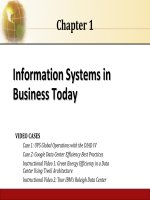Management information systems 13th laudon chapter 04
Bạn đang xem bản rút gọn của tài liệu. Xem và tải ngay bản đầy đủ của tài liệu tại đây (422.38 KB, 35 trang )
Chapter 4
Ethical and Social Issues in
Information Systems
Video cases:
Case 1: “What Net Neutrality Means for You”
Case 2: Facebook Privacy
Case 3: Data Mining for Terrorists and Innocents
Instructional Video 1: “Victor Mayer Schonberger on the Right to be Forgotten”
4.1
Copyright © 2014 Pearson Education, Inc.
Management Information Systems
Chapter 4: Ethical and Social Issues in Information Systems
LEARNING OBJECTIVES
• What ethical, social, and political issues are raised by
information systems?
• What specific principles for conduct can be used to
guide ethical decisions?
• Why do contemporary information systems
technology and the Internet pose challenges to the
protection of individual privacy and intellectual
property?
• How have information systems affected everyday life?
4.2
Copyright © 2014 Pearson Education, Inc.
Management Information Systems
Chapter 4: Ethical and Social Issues in Information Systems
Behavioral Targeting: Your Privacy Is the Target
• Problem: Need to efficiently target online ads.
• Solutions: Behavioral targeting allows businesses and
organizations to more precisely target desired demographics.
• Google uses tracking files to monitor user activity on
thousands of sites; businesses monitor activity on their own
sites to better understand customers.
• Demonstrates IT’s role in organizing and distributing
information.
• Illustrates the ethical questions inherent in online
information gathering.
4.3
Copyright © 2014 Pearson Education, Inc.
Management Information Systems
Chapter 4: Ethical and Social Issues in Information Systems
Understanding Ethical and Social Issues Related to Systems
• Recent cases of failed ethical judgment in business:
– Barclay’s Bank, GlaxoSmithKline, Walmart
– In many, information systems used to bury decisions
from public scrutiny
• Ethics
– Principles of right and wrong that individuals, acting
as free moral agents, use to make choices to guide
their behaviors
4.4
Copyright © 2014 Pearson Education, Inc.
Management Information Systems
Chapter 4: Ethical and Social Issues in Information Systems
Understanding Ethical and Social Issues Related to Systems
• Information systems and ethics
– Information systems raise new ethical questions
because they create opportunities for:
• Intense social change, threatening existing
distributions of power, money, rights, and
obligations
• New kinds of crime
4.5
Copyright © 2014 Pearson Education, Inc.
Management Information Systems
Chapter 4: Ethical and Social Issues in Information Systems
Understanding Ethical and Social Issues Related to Systems
• A model for thinking about ethical, social, and political Issues
– Society as a calm pond
– IT as rock dropped in pond, creating ripples of new
situations not covered by old rules
– Social and political institutions cannot respond
overnight to these ripples—it may take years to
develop etiquette, expectations, laws
• Requires understanding of ethics to make choices in legally gray
areas
4.6
Copyright © 2014 Pearson Education, Inc.
Management Information Systems
Chapter 4: Ethical and Social Issues in Information Systems
THE RELATIONSHIP AMONG ETHICAL, SOCIAL, POLITICAL ISSUES IN AN
INFORMATION SOCIETY
The introduction of new
information technology has a
ripple effect, raising new
ethical, social, and political
issues that must be dealt with
on the individual, social, and
political levels. These issues
have five moral dimensions:
information rights and
obligations, property rights
and obligations, system
quality, quality of life, and
accountability and control.
Figure 4-1
4.7
Copyright © 2014 Pearson Education, Inc.
Management Information Systems
Chapter 4: Ethical and Social Issues in Information Systems
Understanding Ethical and Social Issues Related to Systems
• Five moral dimensions of the
information age:
–
–
–
–
–
4.8
Information rights and obligations
Property rights and obligations
Accountability and control
System quality
Quality of life
Copyright © 2014 Pearson Education, Inc.
Management Information Systems
Chapter 4: Ethical and Social Issues in Information Systems
Understanding Ethical and Social Issues Related to Systems
• Key technology trends that raise ethical issues
– Doubling of computer power
• More organizations depend on computer systems for critical
operations.
– Rapidly declining data storage costs
• Organizations can easily maintain detailed databases on
individuals.
– Networking advances and the Internet
• Copying data from one location to another and accessing personal
data from remote locations are much easier.
4.9
Copyright © 2014 Pearson Education, Inc.
Management Information Systems
Chapter 4: Ethical and Social Issues in Information Systems
Understanding Ethical and Social Issues Related to Systems
– Advances in data analysis techniques
• Profiling
– Combining data from multiple sources to create
dossiers of detailed information on individuals
• Nonobvious relationship awareness (NORA)
– Combining data from multiple sources to find
obscure hidden connections that might help
identify criminals or terrorists
– Mobile device growth
• Tracking of individual cell phones
4.10
Copyright © 2014 Pearson Education, Inc.
Management Information Systems
Chapter 4: Ethical and Social Issues in Information Systems
NONOBVIOUS RELATIONSHIP AWARENESS (NORA)
NORA technology can take
information about people
from disparate sources and
find obscure, nonobvious
relationships. It might
discover, for example, that an
applicant for a job at a casino
shares a telephone number
with a known criminal and
issue an alert to the hiring
manager.
Figure 4-2
4.11
Copyright © 2014 Pearson Education, Inc.
Management Information Systems
Chapter 4: Ethical and Social Issues in Information Systems
Ethics in an Information Society
• Basic concepts for ethical analysis
– Responsibility:
• Accepting the potential costs, duties, and obligations for decisions
– Accountability:
• Mechanisms for identifying responsible parties
– Liability:
• Permits individuals (and firms) to recover damages done to them
– Due process:
• Laws are well-known and understood, with an ability to appeal to
higher authorities
4.12
Copyright © 2014 Pearson Education, Inc.
Management Information Systems
Chapter 4: Ethical and Social Issues in Information Systems
Ethics in an Information Society
• Five-step ethical analysis
1. Identify and clearly describe the facts.
2. Define the conflict or dilemma and identify the
higher-order values involved.
3. Identify the stakeholders.
4. Identify the options that you can reasonably take.
5. Identify the potential consequences of your
options.
4.13
Copyright © 2014 Pearson Education, Inc.
Management Information Systems
Chapter 4: Ethical and Social Issues in Information Systems
Ethics in an Information Society
• Candidate ethical principles
– Golden Rule
• Do unto others as you would have them do unto you.
– Immanuel Kant’s Categorical Imperative
• If an action is not right for everyone to take, it is not right for
anyone.
– Descartes’ Rule of Change
• If an action cannot be taken repeatedly, it is not right to take at all.
4.14
Copyright © 2014 Pearson Education, Inc.
Management Information Systems
Chapter 4: Ethical and Social Issues in Information Systems
Ethics in an Information Society
• Candidate ethical principles (cont.)
– Utilitarian Principle
• Take the action that achieves the higher or greater value.
– Risk Aversion Principle
• Take the action that produces the least harm or potential cost.
– Ethical “No Free Lunch” Rule
• Assume that virtually all tangible and intangible objects are owned
by someone unless there is a specific declaration otherwise.
4.15
Copyright © 2014 Pearson Education, Inc.
Management Information Systems
Chapter 4: Ethical and Social Issues in Information Systems
Ethics in an Information Society
• Professional codes of conduct
– Promulgated by associations of professionals
• Examples: AMA, ABA, AITP, ACM
– Promises by professions to regulate themselves in
the general interest of society
• Real-world ethical dilemmas
– One set of interests pitted against another
• Example: right of company to maximize productivity of workers
versus workers right to use Internet for short personal tasks
4.16
Copyright © 2014 Pearson Education, Inc.
Management Information Systems
Chapter 4: Ethical and Social Issues in Information Systems
The Moral Dimensions of Information Systems
• Information rights: privacy and freedom in the Internet age
– Privacy:
• Claim of individuals to be left alone, free from surveillance or
interference from other individuals, organizations, or state; claim
to be able to control information about yourself
– In the United States, privacy protected by:
• First Amendment (freedom of speech)
• Fourth Amendment (unreasonable search and seizure)
• Additional federal statues (e.g., Privacy Act of 1974)
4.17
Copyright © 2014 Pearson Education, Inc.
Management Information Systems
Chapter 4: Ethical and Social Issues in Information Systems
The Moral Dimensions of Information Systems
• Fair information practices:
– Set of principles governing the collection and use of
information
• Basis of most U.S. and European privacy laws
• Based on mutuality of interest between record holder and
individual
• Restated and extended by FTC in 1998 to provide guidelines for
protecting online privacy
– Used to drive changes in privacy legislation
•
•
•
•
4.18
COPPA
Gramm-Leach-Bliley Act
HIPAA
Do-Not-Track Online Act of 2011
Copyright © 2014 Pearson Education, Inc.
Management Information Systems
Chapter 4: Ethical and Social Issues in Information Systems
The Moral Dimensions of Information Systems
• FTC FIP principles:
– Notice/awareness (core principle)
• Web sites must disclose practices before collecting data.
– Choice/consent (core principle)
• Consumers must be able to choose how information is used for
secondary purposes.
– Access/participation
• Consumers must be able to review and contest accuracy of
personal data.
4.19
Copyright © 2014 Pearson Education, Inc.
Management Information Systems
Chapter 4: Ethical and Social Issues in Information Systems
The Moral Dimensions of Information Systems
• FTC FIP principles (cont.)
– Security
• Data collectors must take steps to ensure accuracy, security of
personal data.
– Enforcement
• Must be mechanism to enforce FIP principles.
4.20
Copyright © 2014 Pearson Education, Inc.
Management Information Systems
Chapter 4: Ethical and Social Issues in Information Systems
The Moral Dimensions of Information Systems
• European Directive on Data Protection:
– Companies must inform people information is
collected and disclose how it is stored and used.
– Requires informed consent of customer.
– EU member nations cannot transfer personal data to
countries without similar privacy protection (e.g., the
United States).
– U.S. businesses use safe harbor framework.
• Self-regulating policy and enforcement that meets objectives of
government legislation but does not involve government
regulation or enforcement.
4.21
Copyright © 2014 Pearson Education, Inc.
Management Information Systems
Chapter 4: Ethical and Social Issues in Information Systems
The Moral Dimensions of Information Systems
• Internet challenges to privacy:
– Cookies
• Identify browser and track visits to site
• Super cookies (Flash cookies)
– Web beacons (Web bugs)
• Tiny graphics embedded in e-mails and Web pages
• Monitor who is reading e-mail message or visiting site
– Spyware
• Surreptitiously installed on user’s computer
• May transmit user’s keystrokes or display unwanted ads
– Google services and behavioral targeting
4.22
Copyright © 2014 Pearson Education, Inc.
Management Information Systems
Chapter 4: Ethical and Social Issues in Information Systems
HOW COOKIES IDENTIFY WEB VISITORS
Figure 4-3
4.23
Cookies are written by a Web site on a visitor’s
visitor’s hard drive. When the visitor returns to that Web site, the
Web server requests the ID number from the cookie and uses it to access the data stored by that server on
that visitor. The Web site can then use these data to display personalized information.
Copyright © 2014 Pearson Education, Inc.
Management Information Systems
Chapter 4: Ethical and Social Issues in Information Systems
The Moral Dimensions of Information Systems
• The United States allows businesses to gather
transaction information and use this for other
marketing purposes.
– Opt-out vs. opt-in model
• Online industry promotes self-regulation over
privacy legislation.
• However, extent of responsibility taken varies:
– Complex/ambiguous privacy statements
– Opt-out models selected over opt-in
– Online “seals” of privacy principles
4.24
Copyright © 2014 Pearson Education, Inc.
Management Information Systems
Chapter 4: Ethical and Social Issues in Information Systems
The Moral Dimensions of Information Systems
• Technical solutions
–
–
–
–
E-mail encryption
Anonymity tools
Anti-spyware tools
Browser features
• “Private” browsing
• “Do not track” options
– Overall, few technical solutions
4.25
Copyright © 2014 Pearson Education, Inc.









